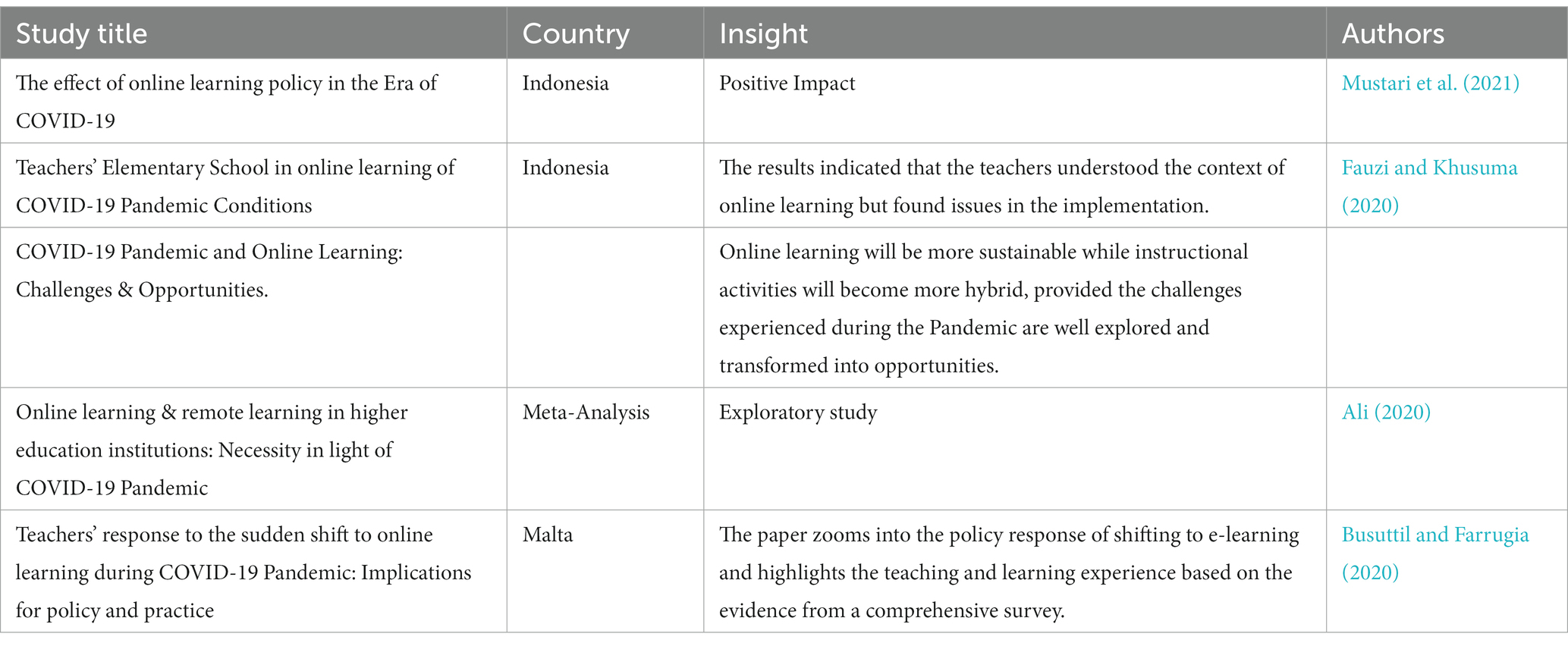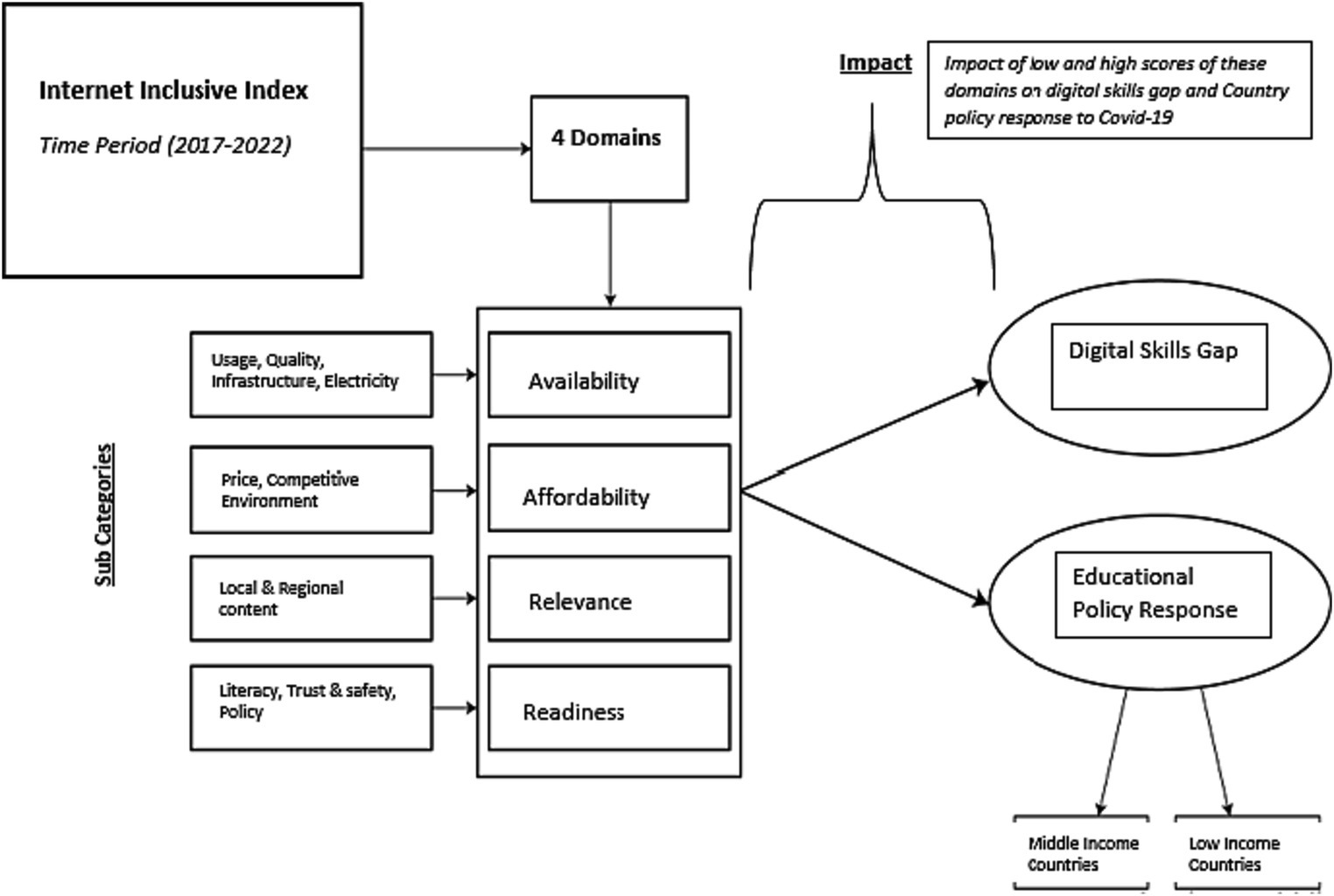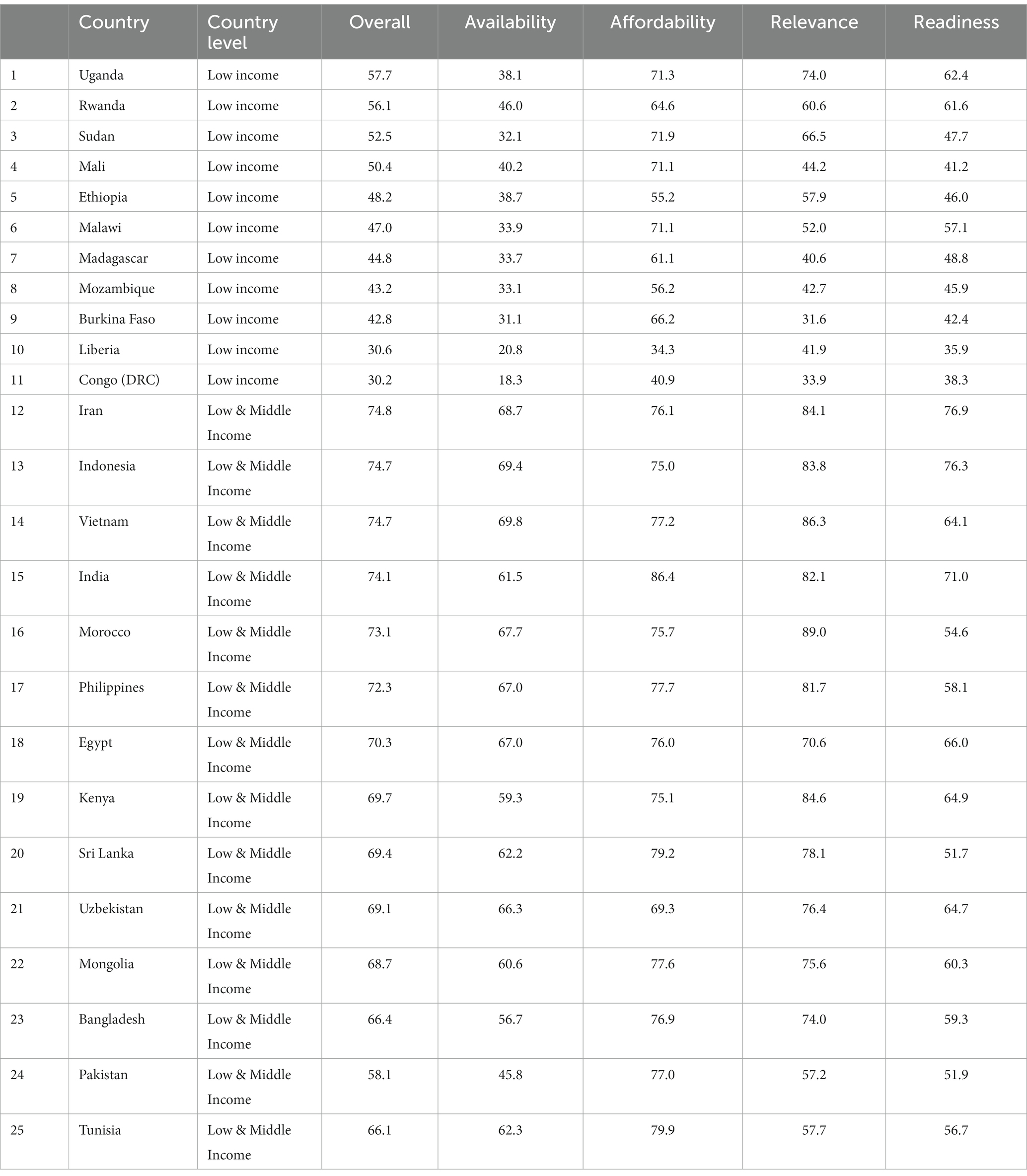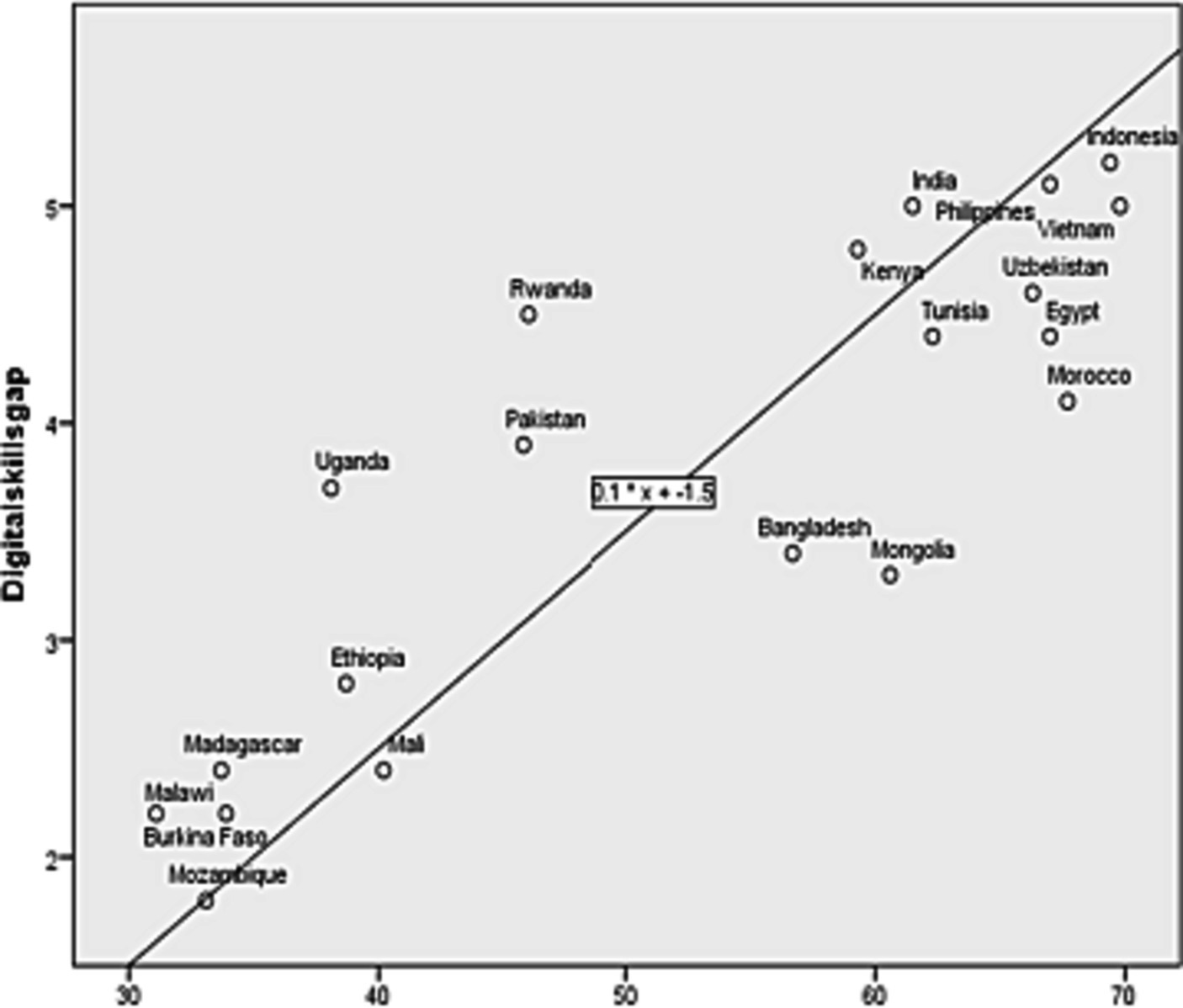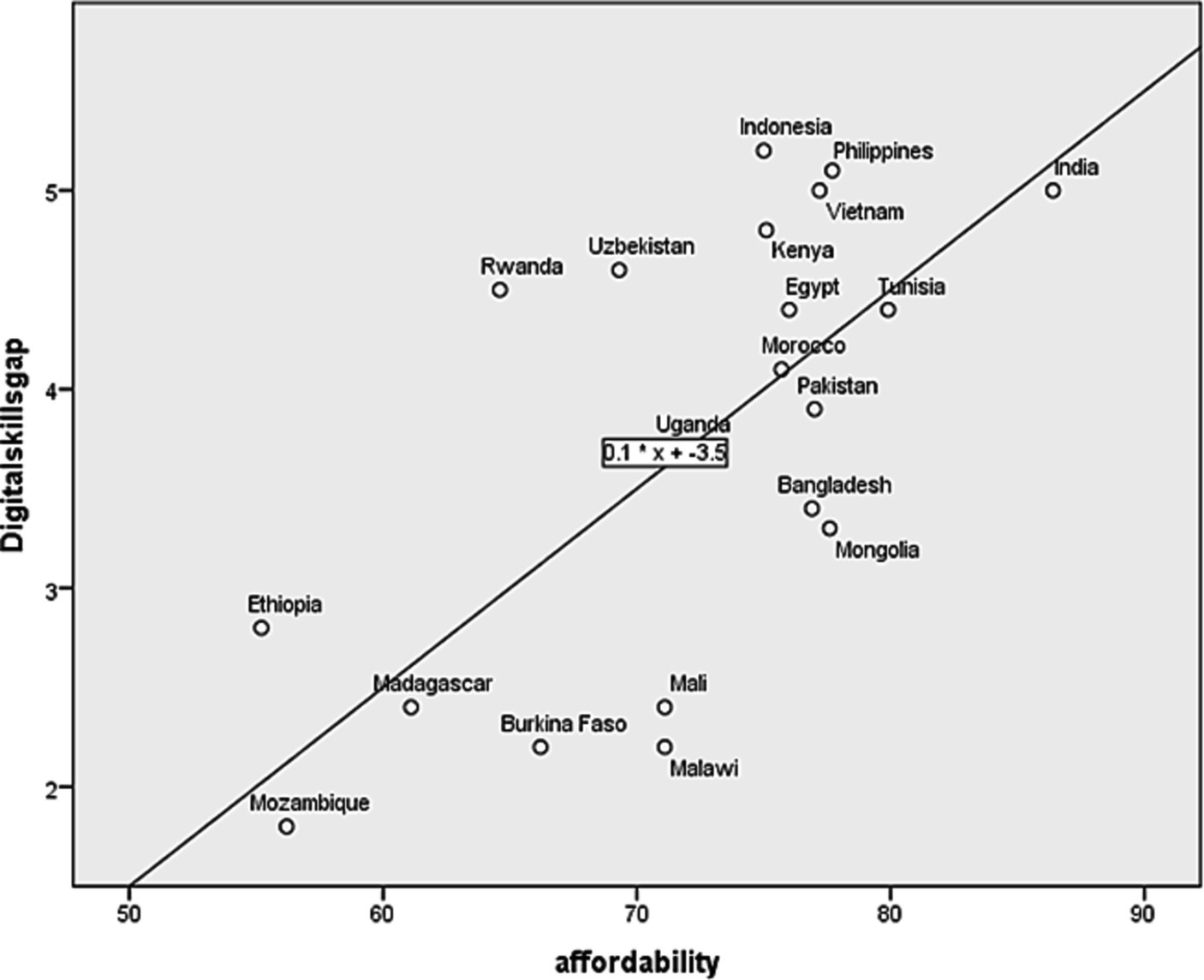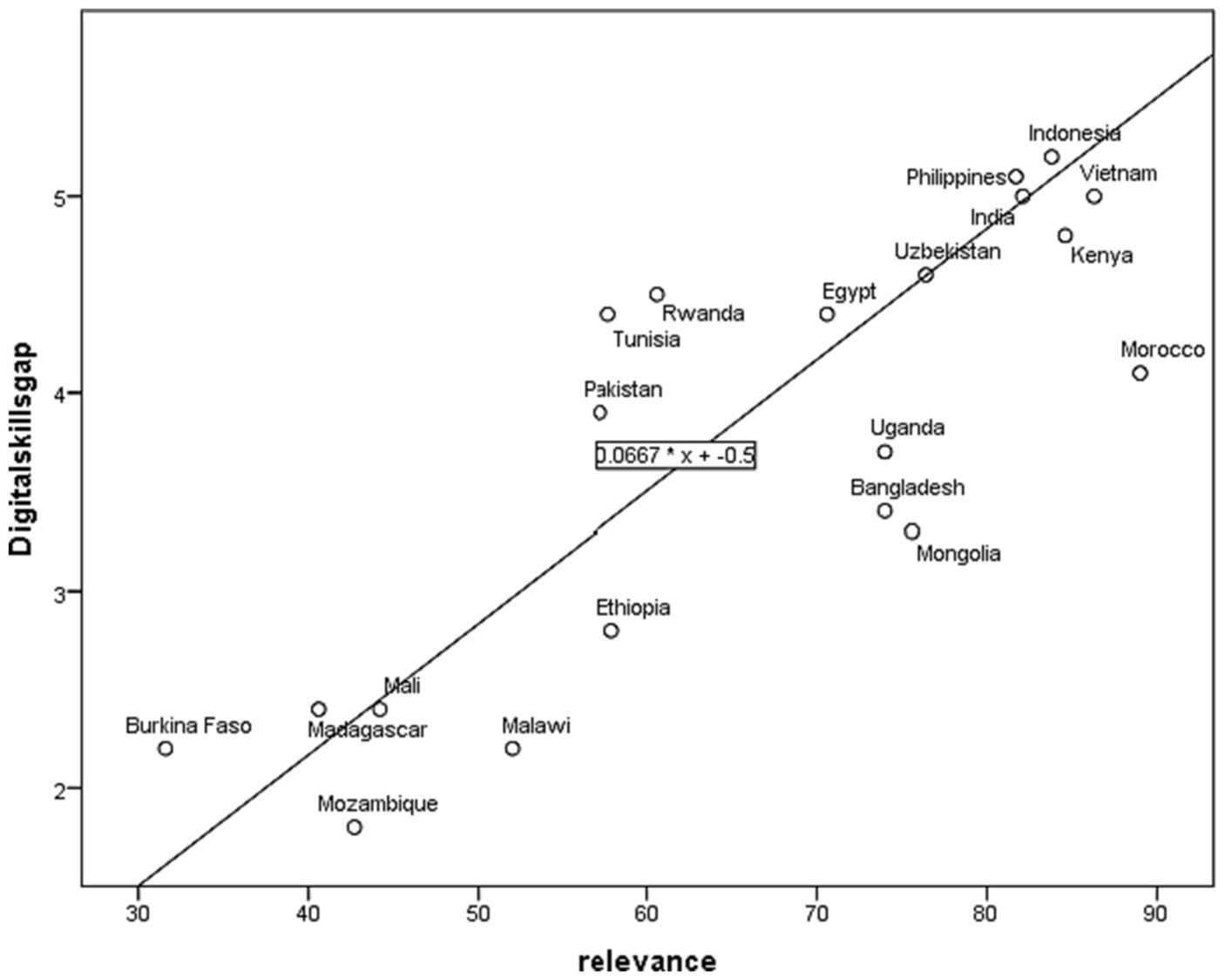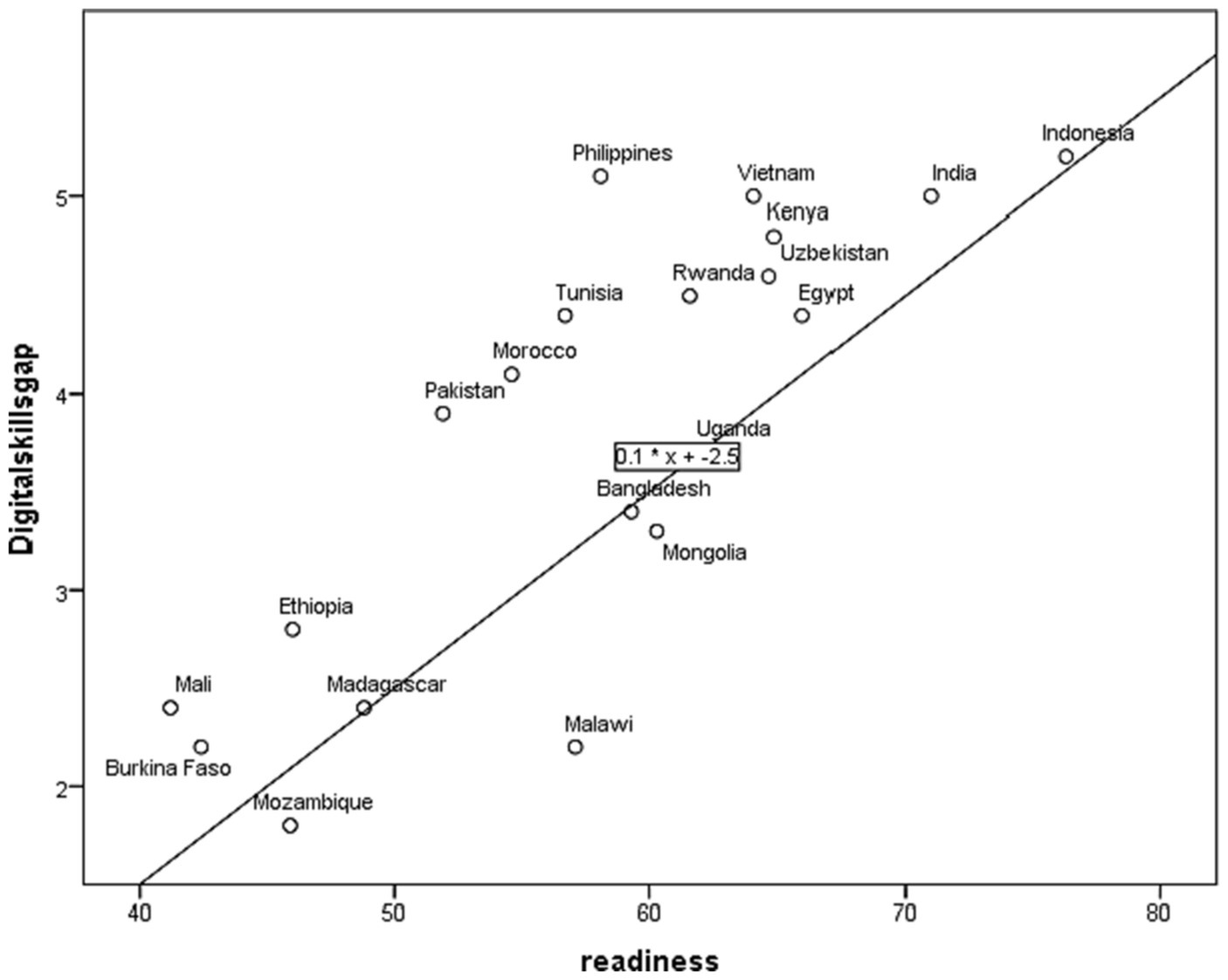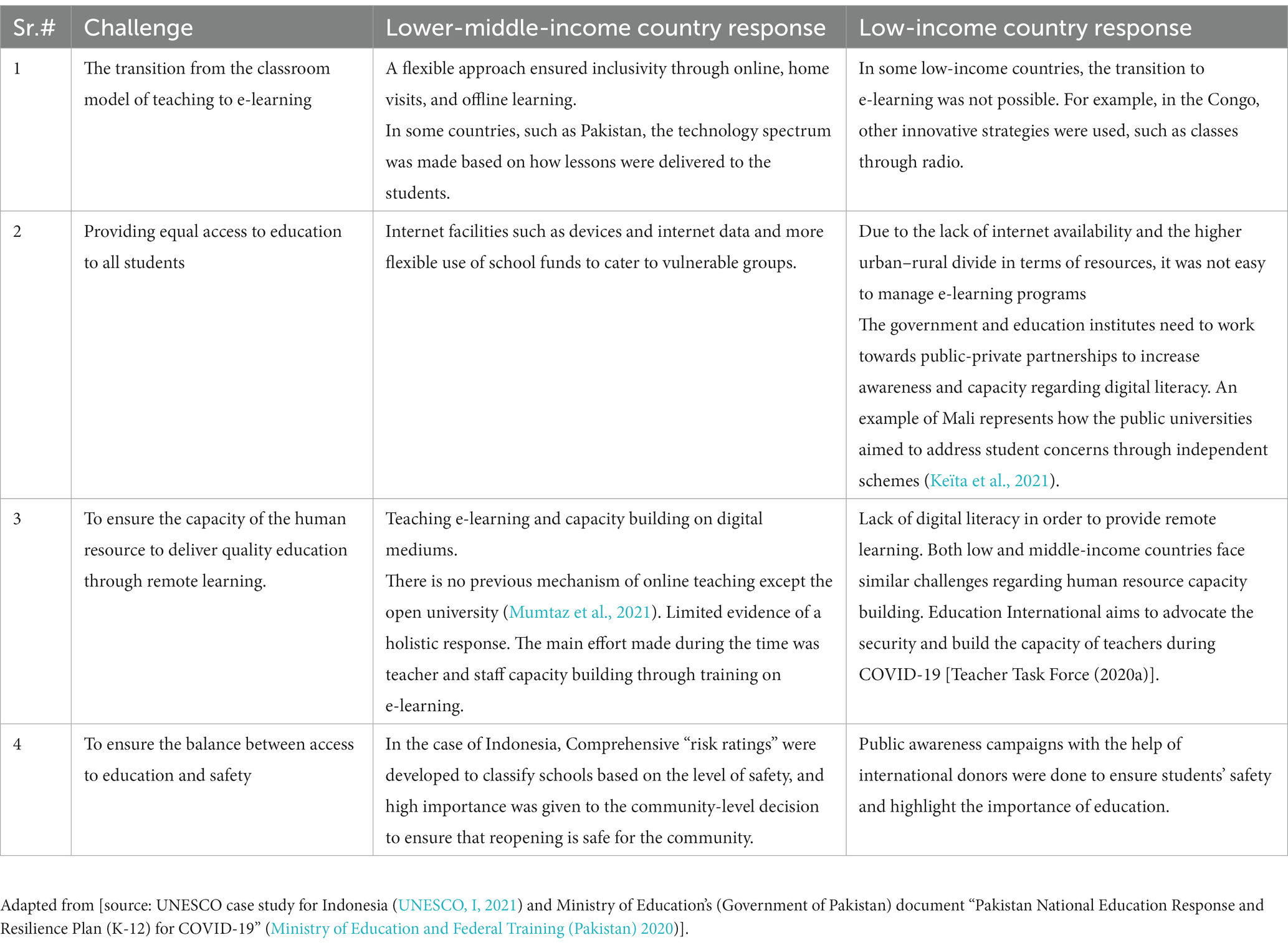- College of Public Policy, Hamad bin Khalifa University, Doha, Qatar
The paper presents a cross-country analysis of 25 low and lower-middle-income countries to investigate the impact of COVID-19 on educational policymaking. The study utilises variables from the Internet Inclusive Index and the Digital Skills Gap Index to explore the relationship between internet access and digital skills gaps in these countries. A descriptive and correlation analysis is conducted to understand trends and associations between the variables from data for the selected countries. The analysis shows a positive correlation between internet domains and digital skills gap scores. The paper also presents insights from low and middle-income countries to understand the challenges and responses to e-learning policy during the Pandemic. The evidence from the analysis suggests that countries with higher scores on internet domains pre-pandemic were in a better position to absorb the external shocks caused by the Pandemic. The paper’s findings highlight the importance of addressing the digital divide and promoting internet inclusivity in these countries to improve their ability to adapt to external shocks and ensure continuity of learning during crises such as the COVID-19 Pandemic.
1 Introduction
Over the past 4 years, the world has experienced an unprecedented pandemic of COVID-19. Various countries have adopted several policy responses as a reaction to this challenge. The pandemic not only created a health crisis but also exacerbated the vulnerabilities of other sectors due to its restrictions related to the lockdown and social distancing (Darmody et al., 2021). According to the guidelines provided by the World Health Organization (WHO) declaration of COVID-19 as a pandemic, globally, most of the countries observed the restriction of lockdown and social distancing. “The COVID-19 pandemic has disrupted education in over 150 countries and affected 1.6 billion students” (Barron Rodriguez et al., 2021, p. 2). These conditions force the education sector to make hard choices regarding education institute closure and going towards alternative methods of learning, one of which was the e-learning model. This paper explores the level of internet inclusiveness across various countries to understand their readiness towards an e-learning model.
In this background, the paper conducts a thematic literature review to explore the history and evolution of e-learning and the dimensions of internet inclusion. Secondly, it presents a theoretical framework to conceptualise the relationship between internet inclusion and e-learning. Thirdly, the paper conducts a cross-country descriptive analysis of 25 low and lower-middle-income countries, providing an in-depth understanding of the current state of internet inclusion in these countries. Fourthly, the paper integrates the findings of the descriptive and correlation analysis of the internet inclusion data and digital skills gap to provide a more comprehensive understanding of the issues at hand. Furthermore, the paper illustrates the contrasting policy challenges and responses of low and middle-income countries, providing valuable insights into addressing these challenges. Lastly, the paper concludes with recommendations for addressing the challenges of internet inclusion and e-learning in the context of future pandemics.
2 Literature review
The thematic review’s rationale was mainly to understand different dimensions of internet inclusivity. Moreover, another reason for selecting this literature method was to explore the literature on COVID-19 and e-learning. The paper derived the thematic areas based on initiating preliminary research using the keywords related to e-learning, internet inclusiveness, and education during the pandemic. The following section provides the literature review based on themes from the initial preliminary research.
2.1 History of e-learning concepts
E-learning has a long history, dating back to the 1960s with the emergence of Computer Assisted Instruction (CAI; Bernhardt, 1960; Kemeny and Kurtz, 1967). CAI focused on computer programming in various fields such as mathematics, psychology, physics, business administration, and statistics. In the late 1960s and early 1970s, the orientation of e-learning started to evolve from being task-oriented to a tool for problem-solving (Lanier, 1966; Hart, 1981; Levy, 1997). This shift in focus marked the beginning of a new era in e-learning, emphasising technology to support problem-solving and critical thinking.
The definition of e-learning adopted by this paper focuses on the use of “electronic sources, providing interactive distance learning. Use of a Web System as a way to access information available, disregarding time and space” (White, 1983; Morri, 1997; Dorai et al., 2001; Piccoli et al., 2001; Rosenberg and Foshay, 2002), this definition highlights the critical features of e-learning, such as the use of technology, interactive learning, and the ability to access information from anywhere at any time.
Over the years, there have been several iterations of the e-learning and hybrid learning models. Some of these iterations have focused on content development, academic management, and learner assessments (Simonson et al., 2015). With new technologies such as mobile devices, gamification, and artificial intelligence, e-learning has become more interactive, engaging, and personalised.
2.2 Previous studies on e-learning
There have been several studies on the evolution of e-learning and the dimensions of internet inclusion. One study by Manca and Ranieri (2016a) analysed the evolution of e-learning from its early beginnings to the present day, highlighting key developments and trends in technology, pedagogy, and the e-learning industry. Another study by Wang et al. (2011) discussed the evolution of e-learning from a historical perspective and identified the main drivers of change, including technological advancements, changes in pedagogy, and the increasing demand for flexible and convenient educational options.
In terms of the dimensions of internet inclusion, a study by Gururajan et al. (2015) explored the impact of internet access on the educational outcomes of disadvantaged students and identified five critical dimensions of internet inclusion: access, relevance, use, empowerment, and impact. Gururajan and Ried (2015) discussed the importance of internet inclusion in promoting social and economic development. They highlighted the importance of addressing the digital divide by focusing on the availability, affordability, and relevance of internet access and providing training and support for internet use.
These studies suggest that the evolution of e-learning and the dimensions of internet inclusion are complex and multifaceted issues influenced by various technological, pedagogical, and socio-economic factors.
Similarly, many studies have been conducted to understand e-learning adoption through the lens of people adopting this form of learning, the quality of the content, and the way the service is delivered (Aparicio et al., 2014). The literature highlighting the dimensions of e-learning has covered the areas focusing on people, technology, and services. Brox et al. (2004) E-learning studies related to the course content and activities, the paper’s finding illustrated a positive response from the teachers and the student regarding the e-learning courses. Another critical opportunity the e-learning mode allows is cross-cultural interaction. In their study, Yang et al. (2014) highlighted the positive student experience regarding cross-cultural collaborative learning.
Then, some studies have investigated e-learning and the digital divide. A study was conducted in Taiwan based on the hypothetical model to understand government policy effectiveness in reducing the urban–rural knowledge divide at the tertiary level of education (Chen and Liu, 2013). In their study, Sims et al. (2008) also identified issues regarding e-learning with the existing digital divide. Their study highlighted that “the digital divide is not adequately addressed by higher education institutions, with some students financially unable to afford technology and broadband access, others lack the skills to engage with learning technology, and some are culturally less able to benefit from technological enrichment.” Other studies conducted on e-learning focus on augmented reality (Bacca Acosta et al., 2014), student satisfaction level of e-learning (Cole et al., 2014), and motivational perspective on e-learning (Keller and Suzuki, 2004).
Previous studies on e-learning in low and middle-income countries (Dabbagh and Bannan-Ritland, 2005; Gururajan and Ried, 2015; Manca and Ranieri, 2016b; Olasehinde-Williams and Adegboyega, 2019) have found that e-learning has the potential to improve access to education, increase the effectiveness and efficiency of teaching and learning, and promote equity and inclusion. However, there are several challenges to implementing e-learning in these countries, including limited access to technology, lack of infrastructure and connectivity, and lack of teacher training and support. Additionally, these studies have also highlighted the digital divide between urban and rural areas, as well as between different socio-economic groups. Studies have also pointed out that the policies related to e-learning in low and lower-middle-income countries are not well-coordinated and often lack a clear vision.
Some studies (Warschauer et al., 2010; Martin and Ertl, 2013; Olasehinde-Williams and Adegboyega, 2019) have also found that the use of e-learning in low and middle-income countries is often limited to basic digital skills and content delivery rather than more advanced uses such as online assessment, collaborative learning, and personalisation. In summary, while e-learning can improve access to education and promote equity in low and middle-income countries, many challenges must be addressed, including lack of infrastructure, limited technology access, and teacher training and support. The digital divide and inadequate policies are also a concern.
2.3 E-learning and COVID-19
The recent studies evaluating and exploring e-learning during COVID-19 have provided various insights, from the positive impact of the e-learning process to the negative impact due to the implementation issues. The findings in the literature provide a different perspective based on the context and the level of technological infrastructure and digital preparedness. In the existing literature, some study themes have emerged in the context of COVID-19 and e-learning.
One of the key themes in the literature is the traditional comparison between online and offline learning. Some studies have attempted to answer the question regarding the effectiveness of these two learning models in the context of the COVID-19 Pandemic. According to Assunção Flores and Gago (2020), Wargadinata et al. (2020), and Wendelboe et al. (2020), face-to-face learning is still a preferred mode of learning due to the obstacles of e-learning.
Additionally, e-learning has been found to take away the classroom experience for students, particularly in practical-oriented subjects that require lab work. According to Wahid et al. (2020), e-learning is not an effective mode of education for these subjects.
Another theme that has emerged in the literature is the issue of the digital divide and the lack of access to technology and internet connectivity among students in low and lower-middle-income countries, and this has highlighted the need for policies and programs that address the digital divide and promote internet inclusivity in these countries.
Furthermore, the literature also highlights the need for teacher training and support and the development of e-learning infrastructure to ensure that e-learning can be implemented effectively during pandemics and other disruptions.
Secondly, another theme in the literature is the human resource capacity to deliver during e-learning. As COVID-19 was a sudden shift, most academics who previously did not have experience working on online platforms faced difficulties in this transition (Wang et al., 2020). Moreover, the academic management in schools in developing countries did not have enough knowledge regarding the e-learning platforms and the software license cost.
There are several studies conducted on human resource capacity to deliver e-learning during the COVID-19 pandemic in low and middle-income countries. The main focus of these studies is on the impact of the COVID-19 Pandemic on e-learning in low and middle-income countries, and many of these studies have identified the challenges teachers and other education professionals face in adapting to e-learning during the Pandemic.
For example, one study by Olasehinde-Williams and Adegboyega (2019) found that the COVID-19 Pandemic has led to a significant increase in the use of e-learning in low and middle-income countries but that the lack of teacher training and support is a significant barrier to the effective implementation of e-learning during the Pandemic. Another study by Manca and Ranieri (2020) found that the COVID-19 Pandemic has highlighted the need for more effective teacher training and support for e-learning in low-income countries and the importance of addressing the digital divide between urban and rural areas and between different socio-economic groups. In summary, studies have shown that the COVID-19 Pandemic has led to a significant increase in the use of e-learning in low and middle-income countries but that the lack of teacher training and support, as well as the digital divide between urban and rural areas and between different socio-economic groups, are significant challenges to the effective implementation of e-learning during the Pandemic.
Thirdly, the adaptability of the students to the e-learning mode. It is not easy to replicate the learning environment of a classroom through e-learning. There are multi-dimensional factors that influence e-learning, such as the learning environment. For instance, a study from Indonesia highlights how e-learning implementation at the school level created difficulties for the students as they needed a conducive environment and access to resources. Moreover, parents complained about the time and resource availability to have e-learning classes at home. Moreover, these difficulties add up for students in low-income households (Baticulon et al., 2021). A recent cross-country survey study on e-learning by (Keržič et al., 2021) highlighted that the quality of e-learning is most important in determining student performance but that student satisfaction with e-learning also plays a significant role. The study also found that service quality, teacher involvement, and system quality are the most critical factors in determining the quality of e-learning.
Then, some studies are relevant to e-learning responses to COVID-19; Table 1 illustrates a series of relevant studies in the context of e-learning policy during COVID-19.
Transitioning to e-learning during COVID-19 raised several questions about the human resource capacity to adopt this teaching model. Hence, some significant studies in the table investigate how teachers responded to this sudden change. Findings illustrate that the teachers can understand the context, but there are implementation issues. These issues may persist in countries with no e-learning models, especially in the cases of primary and elementary-level schooling. In case universities and higher education developing countries do have options of online models that allow the students to access education. An example is Pakistan’s case, where an Open university had online learning before the Pandemic (Mumtaz et al., 2021).
2.4 Dimensions of digital capacity and inclusion
The debate regarding the digital divide exists in the global discussion based on access, affordability, and availability. The current Pandemic has illustrated the widening gap for this inequality. The following Figure 1 illustrates the increase in this gap based on the countries’ income.1
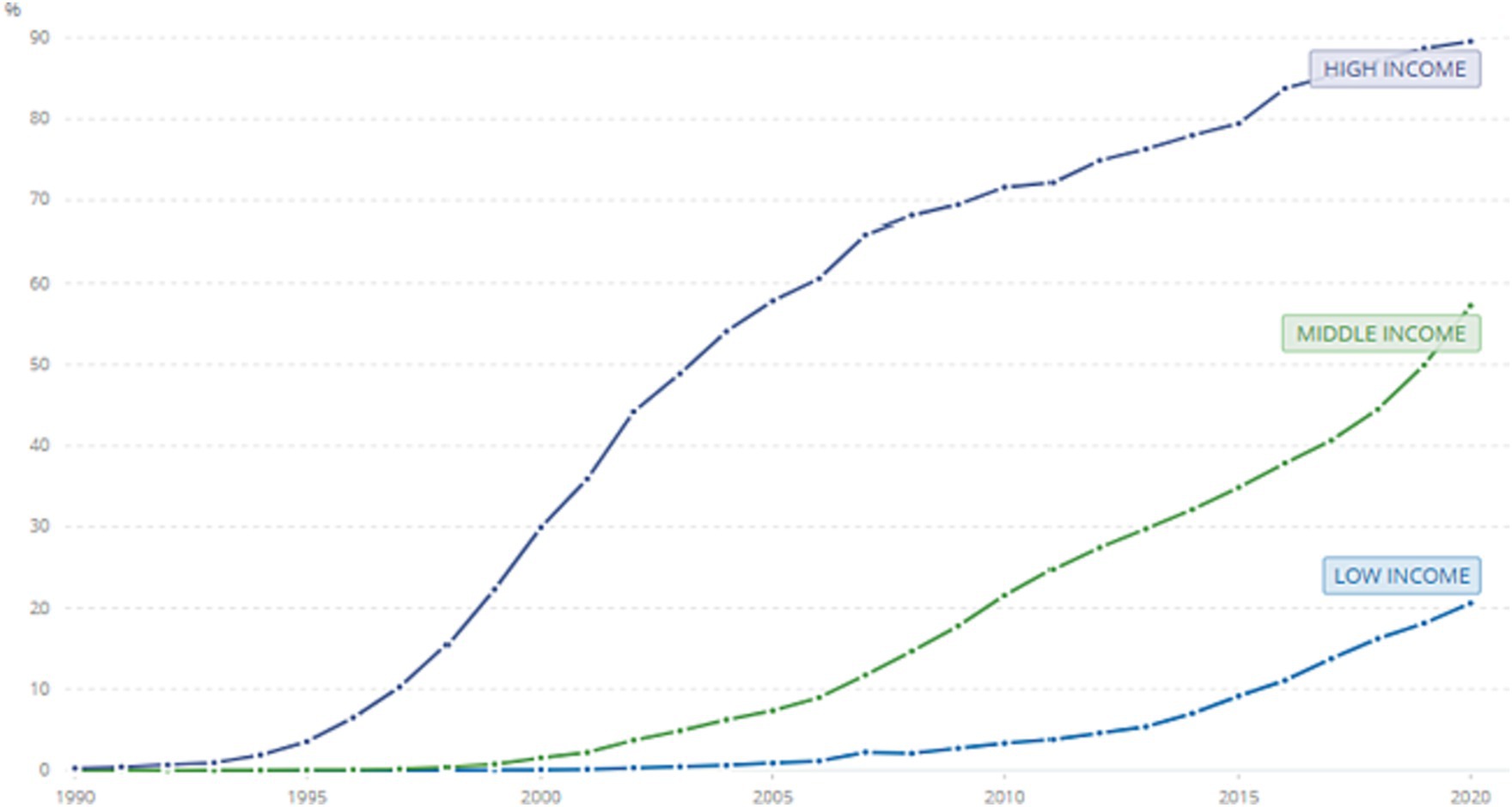
Figure 1. Individuals using the Internet (% of the population) by income (reproduced from World Bank, 2022, licensed under CC BY 4.0).
This visualisation of the gap between the high, middle, and low-income countries provides evidence to explore the middle and low-income countries with lower internet users compared to the high-income countries. The literature in the paper uses factors such as internet affordability, availability, relevance, and readiness to understand how these are crucial for implementing e-learning policies in the education sector.
Firstly, internet availability. In the context of e-learning, this concept means the ability of the student and the teacher to communicate and share information using the internet facility. The non-existence of this service halts the learning program for the students. In developing countries, there are pre-existing challenges related to the urban–rural divide and resource inequalities; these have been exacerbated during the COVID-19 Pandemic. A recent study by Aboagye et al. (2021) highlighted how e-learning was challenging for students in Tertiary Institutions. This study illustrated that one of the critical issues mentioned by the students was the accessibility issues during online learning. Another significant issue highlighted in the background of this section is the inequality of resources. Hossain and Rahman (2017) identified the significance of enhancing internet facilities for individuals in rural areas.
Secondly, Internet Affordability illustrates “the cost of access relative to income and the level of competition in the Internet marketplace.” According to the World Data Lab’s Internet poverty framework, there are two elements related to Internet poverty, i.e., the price of the Internet and the share of the total individual’s expenditure on the Internet.2 Starlink’s exciting study highlights the Internet’s cost by country. This study has explored the cost of the Internet across different countries and each country’s affordability level. The paper dives into complex areas of understanding the concepts related to internet satellite access and other Internet sources. However, Figure 2 illustrates internet penetration and the cost of internet across the countries.
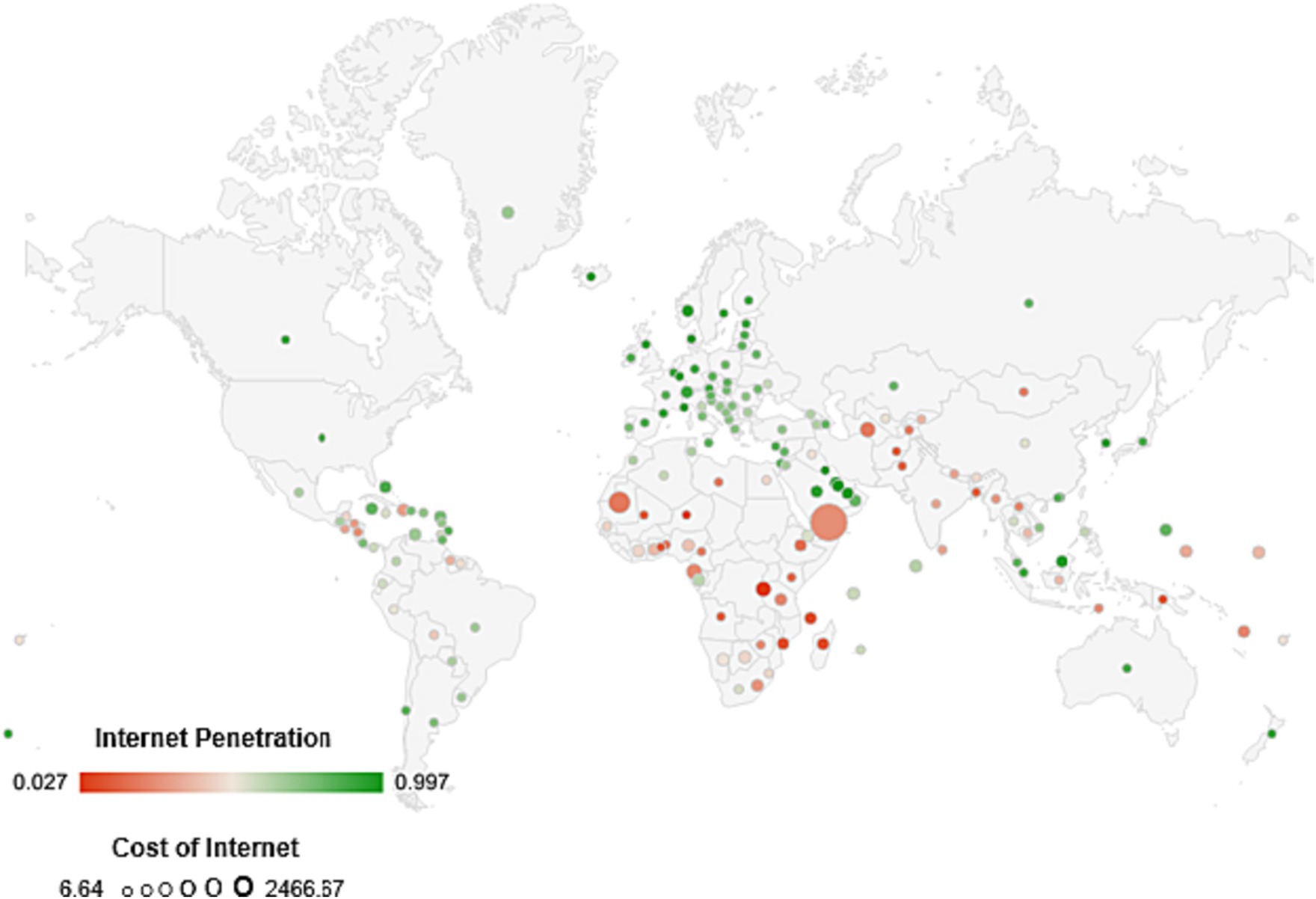
Figure 2. Cost of the Internet across different countries (Data source: Rawls et al., 2020).
Figure 2 illustrates two indicators: the cost of the internet and the internet penetration. The larger the circle, the higher the cost of the internet. On the other hand, green represents a higher percentage of internet penetration. The highest cost of the internet is observed in Yemen, and the internet’s lowest cost is in Ukraine. Moreover, regarding internet penetration, the percentage in Qatar was 99.7%, and Brundi had the lowest percentage at 2.66.
To stress the significance of internet connectivity and availability, a study by the Economist Intelligence unit illustrates that “the nations with low broadband connectivity have the potential to realise up to 20 percent GDP growth by connecting schools to the internet.”
The relevance of digital content and tools is crucial when implementing educational programs or public services. Currently, there are challenges regarding the available digital content as English dominates it, which is a significant challenge for people who need help understanding the language (Davaki, 2018). Davaki (2018) focus is more related to the digital gender gap, and the evidence from Global System for Mobile Communication Association (2015) also provides evidence of inaccessibility and lack of use due to the neglect of the local language.
Lastly, digital readiness is crucial, especially during a pandemic and capacity building. The digital readiness defined by previous studies has stated that it is the capabilities of individuals to understand the transition to digital mediums. In their study, Hong and Kim (2018) mentioned that it should include “cognitive skills and digital proficiency.” Similarly, Jones (2012) in his study indicated that crucial factors such as skills, competency, and the tendency to use technology enhance learners’ capacity in the digital realm.
The current literature and analysis have not explored how low and middle-income countries’ internet capacity impacts the digital skills gap during the Pandemic and what has been the educational policy response of these countries to COVID-19.
3 Theoretical framework
The conceptualisation of e-learning is crucial in understanding the difference between e-learning and digital learning. The critical difference lies in two main areas: design and interaction. In design, digital learning is a holistic approach to delivering lessons that combine digital tools and platforms and can be taught online and offline. On the other hand, e-learning is focused on providing sessions and lectures through fully online formats, particularly for distant or remote learning environments.
Interaction between these two concepts also varies. Digital learning can occur using digital devices in a face-to-face class, whereas e-learning uses digital mediums to conduct virtual classes. In contrast, e-learning has a limited definition of e-learning that relates explicitly to online and remote learning. The study utilises internet inclusivity domains to explore a country’s digital capacity and ability to implement e-learning policies in the education sector: affordability, availability, relevance, and readiness. These domains are used to analyse the situation of internet inclusivity before and after COVID-19 in 25 low and lower-middle-income countries. The rationale for choosing low and lower-middle-income countries is based on the assumption that upper-middle-income and high-income countries have higher levels of internet inclusion. This is supported by data trends, which show that internet penetration rates are generally lower in low and middle-income countries. The selection of the 25 countries in the study was based on data availability.
Furthermore, the study investigates the relationship between internet inclusivity and the digital skills gap, finding an inverse relationship between internet inclusivity and the digital skills gap, meaning that countries with higher internet inclusivity have a reduced digital skills gap. Figure 3 illustrates the framework of the study.
4 Methodology
The analysis uses a two-pronged approach; firstly, it provides a descriptive analysis conducted to understand the trends and variations across different countries (Loeb et al., 2017). The study conducts this analysis across 25 countries based on the Internet Inclusive Index. The paper also describes the trends from the Digital Skills Gap Index data.
The second part of the analysis explores the policy dimensions of low-income and middle-income countries. As described in the theoretical framework, the study presents policy challenges and policy responses of these country categorisations and understands the impact of COVID-19 based on internet inclusivity and secondary data from different reports.
4.1 Data sources
The paper uses one dataset in the primary analysis, the Internet Inclusive Index. Willey has taken other datasets to build the narrative regarding digital literacy from the Digital Skills Gap Index (Digital Skills Gap Index, 2022). Moreover, the policy-level secondary data was abstracted from the country-specific data from the governmental websites to develop the case studies.
4.1.1 Internet inclusive index
The Internet Inclusive Index is a measure that assesses the level of Internet inclusion in a country. This Index comprises four domains: affordability, availability, relevance, and readiness. These domains evaluate the extent to which internet access is affordable, widely available, relevant to users’ needs, and ready for use by the population. The scores on these domains are then used to produce an overall score for the country, which can be used to compare its internet inclusivity with other countries. The Internet Inclusive Index is typically used to understand the digital capacity of a country to implement e-learning policies in the education sector.
This paper uses holistic domains of internet availability, affordability, relevance, and readiness. Each of the domains includes a series of indicators. For instance, availability includes factors like usage, quality, infrastructure, and electricity; these factors develop an overall ranking for each domain. Moreover, the overall ranking for each country is also based on aggregating all four key domains. As is evident from Table 2, this cross-sectional data includes both low and lower-middle-income countries. There are 11 countries with low income and 14 countries with lower middle-income countries. The classification for these countries is based on the Internet Inclusive Index (3i). These overall scores are the representation of data from 2022. The data analysis may be historical to see the impact before and after COVID-19.
4.1.2 Digital skills gap index
The Digital Skills Gap Index is utilised in the study to explore the impact of the digital skills gap on a country’s ability to make policies that influence the general public. This Index comprises six pillars, and this paper has used the overall score of DSGI to develop the analysis. Table 3 illustrates the six pillars.
5 Results/findings
This section illustrates a descriptive visualisation of 25 countries from low-income and lower-middle-income countries in Table 2. The analysis is developed based on the two main data sources, the Internet Inclusive Index and the Digital Skills Gap Index. There are a total of eight key variables included in the study. Appendix A1 presents the definition of each. Table 4 summarises the statistics of the used variables in this study.
Based on the table, the mean overall score for the Internet Inclusive Index is 59.4. Exploring each domain from the table, it is evident which are the major contributors to the overall score. The lowest domain score in the Internet Inclusive Index is internet availability, and the highest contribution by internet affordability. In the background of these scores, it can be stated that the affordability of the Internet is better than the availability in low-income and lower-middle-income countries. Table 5 illustrates further exploration to understand the difference in the scores between the low-income and lower-middle-income countries, representing some interesting insights.
Firstly, the overall mean score for the Internet Inclusive Index for low-income countries is 24.33 less than the lower and middle-income countries, which is a high difference. Secondly, exploring each of the domains from the Index can be visualised as the critical reason for the differences. There is an internet availability score gap of 29.89 between country levels. The availability score in low-income countries also aligns with the literature highlighting the lack of digital infrastructure in low-income countries. The second high difference can be seen in the relevant domain, which illustrates a mean score difference of 27.60. Annexure A.1 evidence regarding the significance of the hypothesis that there is a difference in the mean scores between the low-income and lower-middle-income countries’ overall internet inclusive index.
Thirdly, exploring the DSGI shows that the lower middle’s mean score is 1.63, higher than in the low-income countries. A.2 provides evidence regarding the significance of the hypothesis that there is a difference in the mean scores between the low-income and lower-middle-income countries’ overall digital skills gap score; this represents another structural issue highlighting the lack of human resource skill access and capacity to use digital platforms and devices. In exploring this Index, another critical insight was that the mean difference between the low-income and lower and middle-income countries was only 0.22 in the case of government support; this provides evidence that the governments in the low-income countries understand the prioritisation of capacity-building in the digital domain.
5.1 Correlation analysis
The next phase of the analysis was to identify if there is a correlation between the global skill gap score (DSGI) and the different domains of the internet inclusivity index. Pearson correlation was conducted to assess the relationship across 20 countries in the sample. A correlation coefficient (r) and significant value (p) were calculated, as shown in Table 6. The entries in the table show a positive correlation between internet-inclusive scores and the digital skills gap scores. The table shows that the digital skills gap positively impacts all internet inclusivity domains.
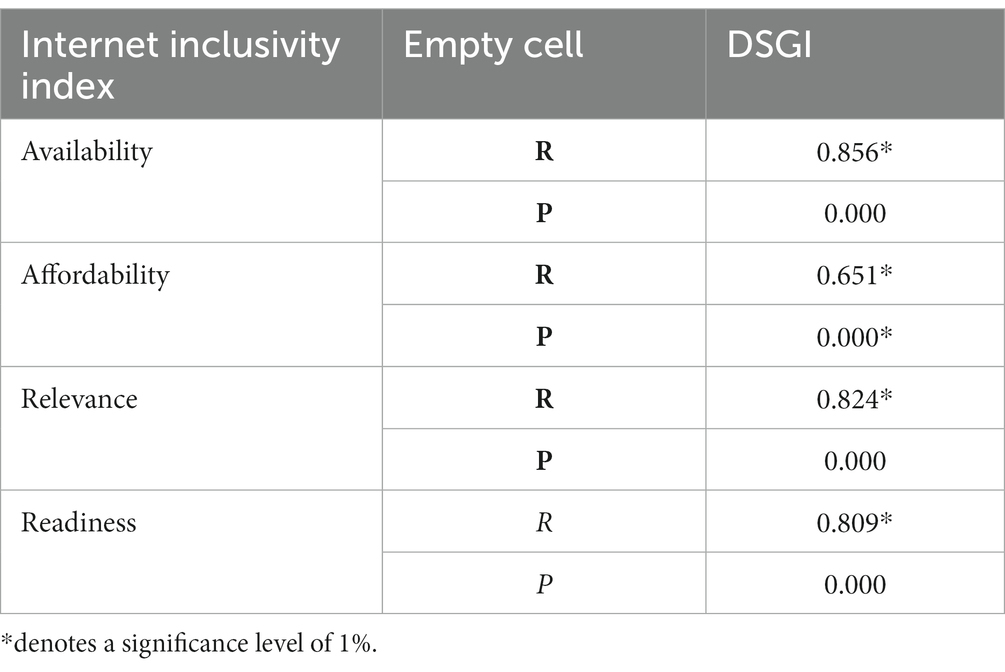
Table 6. Correlation between internet inclusivity domains and digital skills gap score (Appendix B).
Internet availability is significantly (at the 1% level) positively correlated with the digital skills gap; this essentially provides evidence across the sample of selected countries that the countries with a higher level of internet availability have a higher score of digital skills (the country has a smaller digital skills gap).
5.1.1 Internet availability and digital skill gap
Figure 4 illustrates that increased internet availability positively correlates with the digital skills gap score. This graph illustrates how a country’s digital skills gap index might change depending on the internet availability in the country. It is positive because the digital skill gap Index increases as the internet availability score increases. This graph shows that countries with low income also have low internet availability and lower scores on the digital skills gap. The lowest score in this relationship is for Mozambique. Another crucial finding from the figure is that some lower-income countries, such as Uganda, are performing well on the digital skill gap index despite being part of the lower-income countries and having lower-level internet availability.
On the contrary, a country from a lower and middle-income country, Pakistan, has a relatively higher score on the digital skills gap than Bangladesh, which has a higher level of internet availability. However, there is still a more significant digital skill gap to bridge. Understanding the dynamics and inclusion of the various factors within the Index of the digital skills gap is essential. One of the vital pillars is government support, so in the case of Rwanda, there is a high level of government support compared to other countries from the low-income segment. This factor highlights why Rwanda stands out in the figure.
5.1.2 Internet affordability and digital skills gap
Figure 5 illustrates that increased internet affordability positively correlates with the digital skills gap score. This graph illustrates how a country’s digital skills gap index might change depending on the internet availability in the country. It is positive because the digital skill gap scores increase as the internet affordability score increases. In simple terms, if there is an increase in affordability, the digital skills gap will be reduced. Figure 5 shows that low and middle-income countries have higher internet affordability than low-income countries. However, there are few exceptions from the low-income countries, in which the affordability score is high, and the digital skills gap score is high; this could result from many unobservable factors such as the level of government support, the government priorities related to digital transformation and foreign direct investments for the digital skills development.
5.1.3 Internet relevance and digital skills gap
Figure 6 shows a similar trend as explained in the case of the first two domains above. In this case, there is a positive relationship between relevance and digital skill gap score. This graph illustrates how a country’s digital skills gap index might change depending on the internet availability in the country. It is positive because the digital skill gap Index increases as the internet relevance score increases. The relevant internet domain is crucial as it covers the two main contributors to inclusivity, i.e., the local and the relevant content. Internet content that is developed must be contextualised to the local needs. Hence, intuitively, it can be stated that including localised content may reduce the digital skills gap.
5.1.4 Internet readiness and digital skills gap
Figure 7 illustrates a positive relationship between readiness and the digital skills gap. This graph illustrates how a country’s digital skills gap index might change depending on the internet readiness in the country. Internet readiness is at the core of this analysis as it has factors including policies, digital literacy, and trust and safety. The existing literacy across different countries is mapped through this domain. A long-run time series could be used in further analysis to see specific changes in digital literacy. The current analysis highlights the most recent data from 2022. This graph shows that some low-income countries with higher readiness scores also have higher scores for the digital skills gap; an example is Rwanda. In contrast, there are low and middle-income countries where the scores for readiness are not as high as the low-income countries, but they have a higher digital skills gap score. These contrasting examples highlight that other significant factors could influence the digital skill gap scores.
6 Discussion
This section is divided into four parts. Each part focuses on the internet inclusivity domain. Each of these highlight’s discussion regarding variation between low and middle-income countries. The section provides insights based on a series of indicators contributing to each domain. The discussion section uses the sub-indicators for the data to develop arguments; the rationale for including these findings in this section is to identify the positioning of each country with regard to the dimensions of internet inclusivity. The sub-indicators data is taken from the Internet Inclusive Index.
6.1 Internet availability
The analysis has included 11 low-income countries based on the Internet Inclusive Index classification. The results suggest that considering income classification, the one internet domain that could have performed better on the Index is internet availability. The availability score range for these countries is between 18.3 to 40.2. The indicators within the availability domain include factors such as usage, infrastructure, quality, and electricity. Figure 8A illustrates the percentage of internet users across low-income countries.
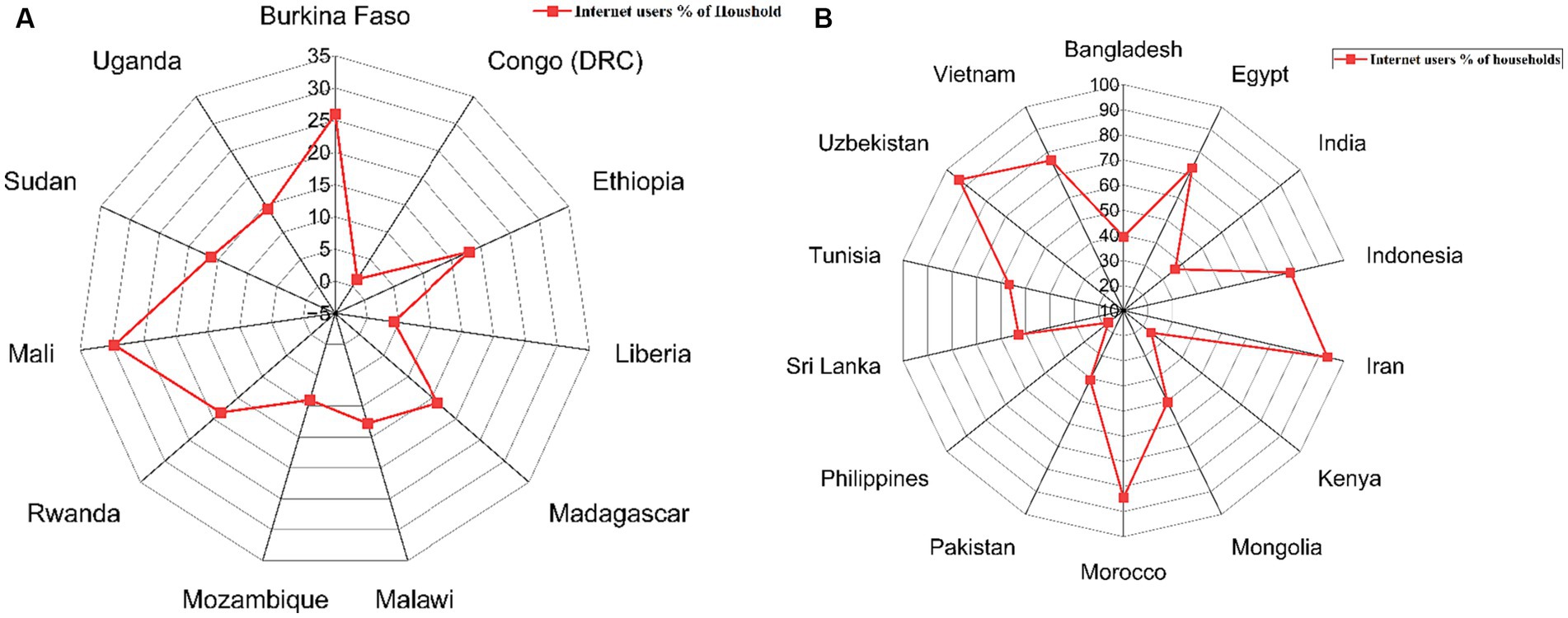
Figure 8. (A) Low income-Internet users % of households. (B) Lower-middle-income: Internet users % of households.
This figure illustrates a variation in the number of internet users within this income group of countries. For instance, the Congo has 1.8% of households with internet users. On the other hand, Mali has the highest number of internet users in this group, 29.6%, and this can be explained through various factors, such as the existing inequalities in the country related to gender and the level of internet infrastructure in the country. In continuation to the same country comparison, it is visible from statistics that the gender gap in internet access for Congo is 21% more than in Mali. Moreover, Congo’s fixed broadband per 100 inhabitants is the lowest in this selected country.
The analysis has used 14 lower-middle-income countries in the analysis. Compared to low-income countries, middle-income countries, on average, show higher results for internet availability than lower-income countries. The mean score for Lower-middle-income countries is 29.5, higher than that of low-income countries. Figure 8B illustrates how different middle-income countries have higher internet users than most selected countries. The highest percentage of users is for Iran at 93.3%, and the lowest is for the Philippines at 17.3%. It is interesting to see that the statistics for the Philippines have a higher gender gap difference for internet access compared to Iran. There is a vast difference if these statistics are compared with lower-income countries. For example, let us compare the country with the lowest internet users in the Philippines, Mali, a lower-income country. Mali has a 16.4% higher difference than the Philippines.
Another crucial factor that impacts e-learning is the availability of electricity, which directly impacts the learning experience; this trend can be observed in low-income and middle-income countries. The following Figures 9A,B illustrate the availability of electricity in both these categories’ urban and rural areas.
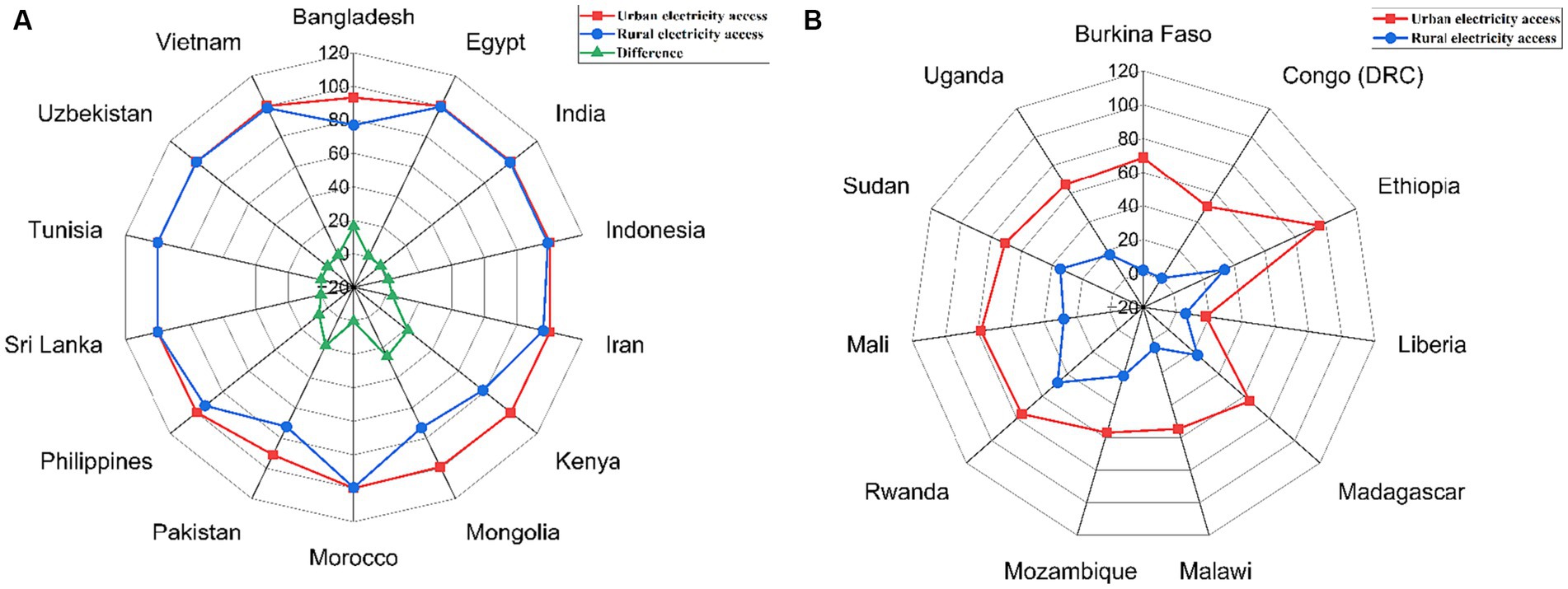
Figure 9. (A) Lower-middle income: urban & rural electricity access. (B) Low income: urban & rural electricity access.
These figures illustrate interesting observations related to the urban–rural divide regarding electricity access. The simplistic explanation based on the figure is that there is a more comprehensive urban and rural gap between lower-middle-income countries. For example, the highest urban–rural gap in the case of low-income countries is 66.8% (Burkina Faso), and the highest gap in the middle-income category is 25.9% (Mongolia). These observations from the data indicate multi-level issues that impact Internet availability and influence learning continuity. During the Pandemic, these factors, especially for the rural population, restricted the e-learning process. A recent study in Uganda’s case highlights that distant learning is complex due to lack of electricity that results in reduced opportunities to learning the digital mediums such television (Tumwesige, 2020). Moreover, the study highlights the poverty as a crucial factor that is constraint for households to use the television subscriptions.
6.2 Internet affordability
Internet affordability was another crucial theme highlighted in studies related to the Pandemic that illustrated constraints for the learners to access the Internet. The two leading indicators investigated through the Internet Inclusivity Index is mobile phone cost (postpaid tariff) and fixed-lined monthly broadband cost. Figures 10A,B illustrates these two variables as a measure of GNI per capita for low-income and middle-income countries.
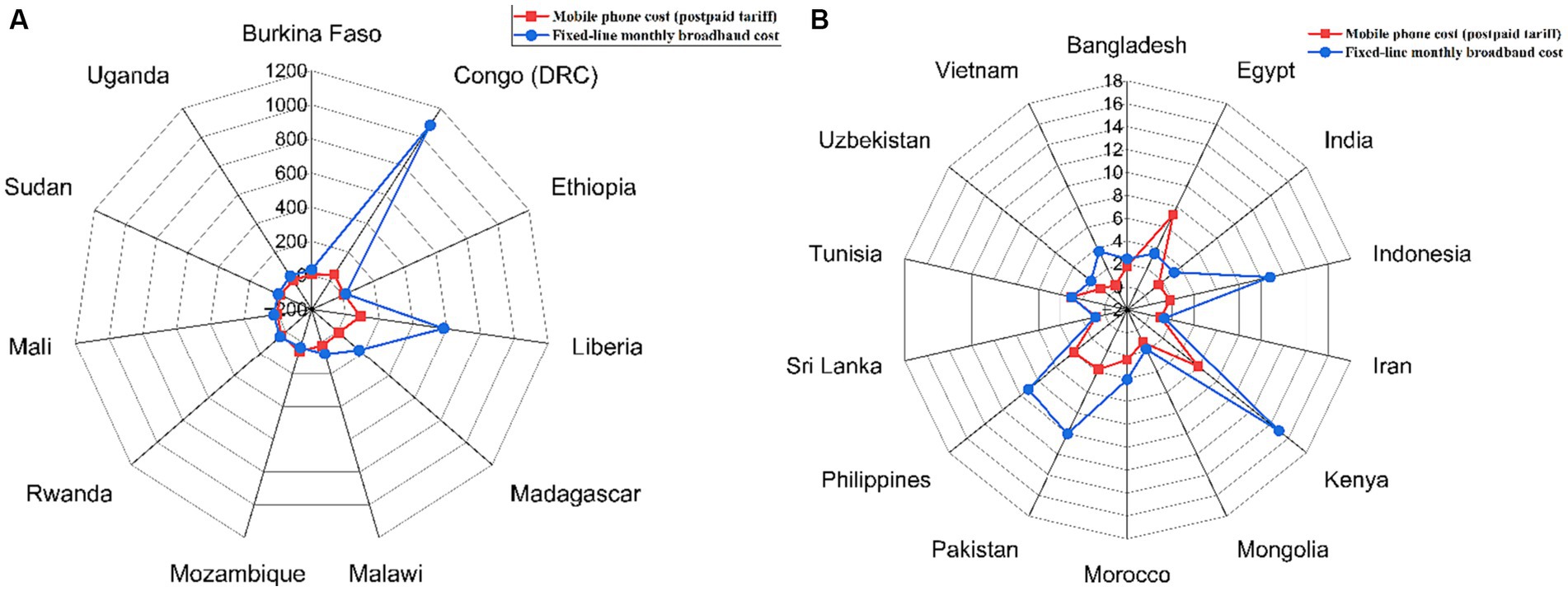
Figure 10. (A) Low income: cost of internet service. (B) Lower-middle income: cost of Internet service.
Congo and Liberia both have a very high cost for fixed-line monthly broadband. According to a locally published African report, a gigabyte represents 20.6% of monthly income.3 These countries that lacked internet affordability also drastically impacted learning continuity. However, in the Congo, an innovative strategy such as radio was used to ensure that learning was possible during the Pandemic.4 Similarly, the use of radio was a popular option for learning continuity in the case of Uganda (Tumwesige, 2020). Investigating the figure for the middle-income countries shows that all countries in the analysis have lower costs than the low-income countries. A rationale for these estimates could be the higher competition amongst internet providers in middle-income countries.
A study conducted to understand the transition to online during the pandemic highlighted that how students in Pakistan were not satisfied with the access to internet and affordability of the gadgets compared to Brunie (Qazi et al., 2020). However, this study highlights other factors such as the cost of equipment to learn such as laptops or tablets. Another study conducted in the Uzbek context also affirms that the sudden shift towards education had socioeconomic issues including the affordability aspects of internet (Khusanov et al., 2022).
6.3 Relevance
This internet inclusivity domain focuses on various indicators related to the availability of local content for e-governance, e-finance, e-health, and e-commerce. The domain is explored in the context of e-education as a qualitative rating. The rating is based on four categories, as illustrated in Table 7.
In the case of low-income countries, 55% of the countries in the selected sample have an online education platform that provides education services in the local languages for primary, secondary, and/or tertiary/vocational education. 18% of the low-income countries do not have such a platform in their local official language. In contrast, in the lower-middle-income countries, 50% of countries in the sample have online education in the local official language in all types of education levels. Furthermore. 14% of the companies do not have online education services in the local official language (Appendix C). It is crucial to acknowledge that these statistics are post-pandemic; intuitively, it indicates that before the Pandemic, e-education services were not the priority for low and middle-income countries.
6.4 Readiness
This domain is also an integral part of this paper as it focuses on the level of readiness based on factors such as literacy, trust and safety, and policy measures to assist internet inclusion. In e-learning, the literacy and education attainment variables are essential. The literacy levels are defined as “Assesses the extent of literacy within countries. To use the Internet for useful purposes, such as to read news, access health or educational information, people must have the ability to read” (Economist, 2022). Figures 11A,B illustrates the literacy level in low-income countries and middle-income countries.
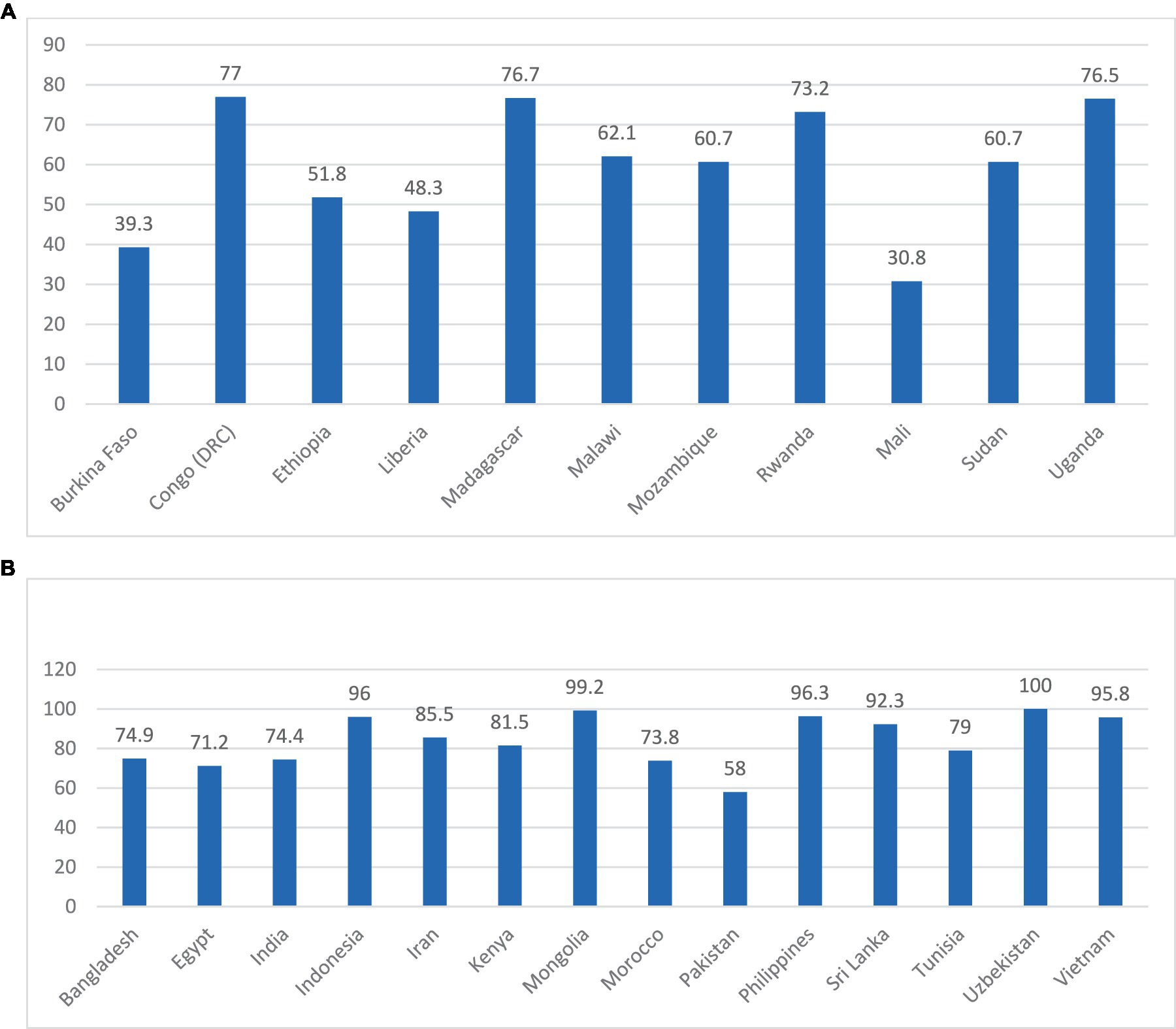
Figure 11. (A) Low-income countries: level of literacy % of population. (B) Lower-middle-income countries: level of literacy % of population.
The country with the highest literacy level as a percentage of the population is Congo (77%); this is an interesting observation in the context of internet inclusivity and e-learning. It has been established that Congo lacks internet availability, which may have impacted the continuity of the learning process. The lowest literacy level as a percentage of the population is in Mali (30.8%). A study by (Keïta et al., 2021), addressed the challenged faced by education system in Mali due to the lack of the priority towards education, these issues were further exacerbated due to the pandemic. Another important indicator to understand the education dynamics in these countries is the educational attainment measured through years of schooling. There is a variation across different countries for this indicator, ranging from 1.6 to 6.8 years on average.
In the case of lower-middle-income countries, the literacy level as a percentage of the population is higher compared to low-income countries. Uzbekistan has the highest literacy, and Pakistan has the lowest. There is a variation across different countries for this indicator, ranging from 5.6 to 11.8 years on average.
7 Pandemic: policy challenges and response
These trends provide evidence to build the argument that the countries with higher Internet-inclusive scores could absorb the shocks from COVID-19 to continue their progress towards highlighted internet domains. All these factors have a positive correlation with the digital skills gap. As discussed in the above section, this brings the analysis to the questions regarding the educational policy challenges and response during the Pandemic. This section first identifies the significant educational policy challenges faced by different countries during the Pandemic. Secondly, it presents the policy response by the countries. The analysis does not present a comprehensive discussion on the effectiveness as it requires primary data and quantitative rigor to answer such questions.
7.1 Challenges
The challenges faced during COVID-19 were multi-dimensional; each sector was affected differently. This section focuses on the challenges the education policymakers faced during the Pandemic. Firstly, the transition from the classroom model of teaching to e-learning. Secondly, providing equal access to education to all students. Thirdly, to ensure the human resource’s capacity to deliver quality education through remote learning. Lastly, the crucial challenge is ensuring the balance between education and safety access (UNESCO, 2021; Table 8).
7.2 Response
The table above shows that both countries utilised mostly similar policy responses in the educational context of COVID-19. The question regarding the effectiveness is a puzzle as most evaluations on these different policies are still processed (Table 8). One key aspect that could impact similar policies differently could be the discussion based on the quantitative analysis between the countries that illustrate pre-existing environments before COVID-19.
The findings of this research paper suggest that countries with better scores on internet domains were better able to absorb the external shock from COVID-19, which suggests a causal inference that these countries may have more effective policies than countries with low scores on the internet inclusivity index. To further strengthen this analysis, a longitudinal study could investigate the impact of the COVID-19 policy response on education and e-learning over time. This study, recommended for future research, could track changes in digital skills gaps, internet inclusivity, and educational policy responses in different countries over several years. Moreover, it could provide insights into the long-term effects of the COVID-19 Pandemic on education and e-learning in low and lower-middle-income countries and help policymakers design more effective policies to address the digital divide and improve internet inclusivity.
7.3 Policy recommendation
The policy recommendations are based on an analysis of low and middle-income countries. They highlight available policy options and specific recommendations for low and middle-income countries. During the Pandemic, the Sustainable Development Goals (SDGs) have been impacted, particularly SDG 4 (Education) and SDG 5 (Gender Equality). School closures resulting from the COVID-19 lockdown have led to a high percentage of students discontinuing in-person learning, with an estimated 35% of children unable to access remote learning, according to UNICEF estimates (Galvin, 2022). Most of this percentage comprised students from rural areas with limited internet access. This lack of access to the Internet is not just an issue of the digital divide but is also related to the distribution and allocation of resources, exacerbating social exclusion.
Similarly, the deterioration of SDG 5 can be linked to patriarchal societies in developing countries (Jayachandran, 2015). Governments in various countries have introduced awareness and inclusion programs to increase female participation in education during the COVID-19 Pandemic (Galvin, 2022). For example, e-learning infrastructure in Tanzania was supported by using sustainable solar energy from solar panels to power personal computers (Olson et al., 2011). Governments with higher urban–rural divides in terms of access to electricity (Jennifer et al., 2011) may adopt similar practices to ensure continuity of learning.
Moreover, another recommendation is prioritising investment in infrastructure related to developing e-learning environments. Fundamentally, it includes investing in infrastructure development to increase the availability and affordability of the Internet across the countries. In the case of low-income countries, there has been an added constraint due to the Pandemic. However, with assistance from local and international partnerships, some commitment towards reducing internet exclusion may positively influence educational outcomes.
Furthermore, the government needs to allocate specific education fund that includes the budget to improve internet availability and affordability to mitigate external shocks such as the Pandemic. Similarly, governments and telecommunication companies can develop low-cost internet access options. These cost-effective solutions include having open-source software, cloud-based storage, and e-learning platforms and promoting mobile devices and apps for learning. Furthermore, the government may provide subsidies based on specific criteria to those who cannot afford the Internet.
Ensuring inclusivity that considers the importance of marginalised communities and female participation is crucial. Governments and international organisations must develop programs financially supporting the vulnerable during the crisis. Another significant challenge for female students is that e-learning might not be ideal for them due to the extra burden of domestic work at home. However, this is an unexplored study area—the patriarchal structures in many low- and middle-income countries. However, a study focusing on the impact of school closures and pre-schools during the Pandemic provides evidence of how women in academic work increased twofold due to additional domestic responsibilities (Yildirim and Eslen-Ziya, 2021).
Another policy recommendation is to enhance human resources to understand the application of the e-learning model. This policy could be effective if the curriculum includes e-learning elements and is relevant and locally focused. Governments should ensure the curriculum includes e-learning elements to ensure positive interactions between teachers and students. Studies have shown that the content delivered during e-learning is often static, which can lead to a lack of motivation among students. E-learning platforms have evolved rapidly during the COVID-19 Pandemic and have added features to create a more dynamic learning environment. However, there is still a question about the capacity of teachers to teach in these environments. Therefore, it is necessary to invest in developing a curriculum that includes e-learning elements and provide training to teachers on how to use e-learning platforms and tools effectively. This policy can include providing them with resources, guidelines, and best practices for online teaching and learning.
To ensure that teachers are up to date with technological advancements and have job security in the event of future school closures, organisations or unions similar to teacher task forces should be developed across different countries. In the case of Pakistan, the Ministry of Education and Federal Training (Pakistan, 2020) adopted this strategy. The COVID-19 Pandemic has also provided sufficient data for policymakers and education institutions to understand student behaviour and prepare for similar situations in the future.
Government representatives in decision-making positions from several developing countries need more insight into constantly evolving technology-related issues. Governments should consider including technical assistance in parliament to respond to emergencies, familiarise parliamentarians with technological advancements, and create Parliamentary Offices of Science and Technology (POST) to provide technical assistance and fast-track legislative processes in the event of external challenges similar to those faced during the COVID-19 Pandemic. The core objective of POST is to provide independent analysis to elected governments based on data and information collated by industry experts and academia (Norton, 1997). An example of the application of POST is from the United Kingdom, where studies conducted by POST during the COVID-19 Pandemic have provided valuable insights for policymakers.
8 Conclusion
This research paper aims to assess the impact of internet inclusivity in low and lower-middle-income countries on their digital skills gap. The study uses recent data to understand the dynamics of the digital skills gap post-pandemic. The results of the cross-country analysis show that countries with higher scores for internet inclusivity have a positive and significant relationship with digital skills. High internet inclusivity scores can help reduce the digital skills gap.
The study also examines the educational policy response of low and middle-income countries. These countries typically have limited resources of internet domains, which affects their ability to implement e-learning programs. Inadequate infrastructure, lack of digital literacy, and higher costs for internet access are some of the issues these countries face in implementing e-learning programs.
The study highlights that the inequality of resource access existed before COVID-19 but was exacerbated due to the COVID-19 lockdowns; this highlights the need for policies and programs that address the digital divide and promote internet inclusivity in low and lower-middle-income countries. It also suggests that addressing the digital skills gap in these countries requires a comprehensive approach that considers the various challenges that these countries face regarding internet access, digital literacy, and infrastructure.5
Data availability statement
The original contributions presented in the study are included in the article/Supplementary material, further inquiries can be directed to the corresponding author.
Author contributions
ME: Conceptualization, Data curation, Formal analysis, Investigation, Methodology, Writing – original draft. EZ: Conceptualization, Funding acquisition, Methodology, Resources, Supervision, Validation, Visualization, Writing – original draft, Writing – review & editing.
Funding
The author(s) declare that no financial support was received for the research, authorship, and/or publication of this article.
Conflict of interest
The authors declare that the research was conducted in the absence of any commercial or financial relationships that could be construed as a potential conflict of interest.
Publisher’s note
All claims expressed in this article are solely those of the authors and do not necessarily represent those of their affiliated organizations, or those of the publisher, the editors and the reviewers. Any product that may be evaluated in this article, or claim that may be made by its manufacturer, is not guaranteed or endorsed by the publisher.
Supplementary material
The Supplementary material for this article can be found online at: https://www.frontiersin.org/articles/10.3389/feduc.2023.1301135/full#supplementary-material
Footnotes
1. ^https://data.worldbank.org/indicator/IT.NET.USER.ZS?end=2020&locations=XM-XP-XD&start=1990&type=shaded&view=chart
2. ^https://www.brookings.edu/blog/future-development/2021/07/26/measuring-internet-poverty/
3. ^https://www.theafricareport.com/107259/africa-which-countries-charge-the-most-for-internet-data/
4. ^https://www.globalpartnership.org/blog/democratic-republic-congo-increasing-alternatives-ensure-learning-continuity-during-covid-19
5. ^https://www.youtube.com/watch?v=HanMAzvQk60&ab_channel=JacobusCilliers
References
Aboagye, E., Yawson, J. A., and Appiah, K. N. (2021). COVID-19 and E-Learning: The Challenges of Students in Tertiary Institutions. Social Education Research, 1–8. doi: 10.37256/ser.212021422
Adedoyin, E., Yawson, J. A., and Appiah, K. N. (2021). COVID-19 and E-Learning: The challenges of students in tertiary institutions. Social Education Research, 1–8. doi: 10.37256/ser.212021422
Ali, W. (2020). Online and remote learning in higher education institutes: a necessity in light of COVID-19 pandemic. High. Educ. Stud. 10, 16–25. doi: 10.5539/hes.v10n3p16
Aparicio, M., Bacao, F., and Oliveira, T. (2014). Trends in the e-learning ecosystem: A bibliometric study.
Assunção Flores, M., and Gago, M. (2020). Teacher education in times of COVID-19 pandemic in Portugal: national, institutional and pedagogical responses. J. Educ. Teach. 46, 507–516. doi: 10.1080/02607476.2020.1799709
Bacca Acosta, J. L., Baldiris Navarro, S. M., Fabregat Gesa, R., and Graf, S. (2014). Augmented reality trends in education: a systematic review of research and applications. J. Educ. Technol. Soc. 17, 133–149.
Barron Rodriguez, M. R., Cobo Romani, J. C., Muñoz-Najar, A., and Sánchez Ciarrusta, I. A. (2021). Remote learning during the global school lockdown: Multi-country lessons (English). Washington, D.C.: World Bank Group.
Baticulon, R. E., Sy, J. J., Alberto, N. R. I., Baron, M. B. C., Mabulay, R. E. C., Rizada, L. G. T., et al. (2021). Barriers to Online Learning in the Time of COVID-19: A National Survey of Medical Students in the Philippines. Medical Science Educat 31, 615–626. doi: 10.1007/s40670-021-01231-z
Bernhardt, V. (1960). A behavioral analysis of the use of computers in education. J. Educ. Psychol. 51, 3–8.
Brox, C., Painho, M., Bação, F., and Kuhn, W. (2004). International exchange of e-learning courses. Lisboa: Proceedings of EUGISES P1070–312.
Busuttil, L., and Farrugia, R. C. (2020). Teachers’ response to the sudden shift to online learning during COVID-19 pandemic: Implications for policy and practice.
Chen, R. S., and Liu, I. F. (2013). Research on the effectiveness of information technology in reducing the rural–urban knowledge divide. Comput. Educ. 63, 437–445. doi: 10.1016/j.compedu.2013.01.002
Cole, M. T., Shelley, D. J., and Swartz, L. B. (2014). Online instruction, e-learning, and student satisfaction: a three year study. Int. Rev. Res. Open and Distributed Learn. 15, 112–126. doi: 10.19173/irrodl.v15i6.1748
Dabbagh, N., and Bannan-Ritland, B. (2005). Online learning in teacher education: programs and practices. J. Teach. Educ. 56, 473–480.
Darmody, M., Smyth, E., and Russell, H. (2021). Impacts of the COVID-19 control measures on widening educational inequalities. Young 29, 366–380. doi: 10.1177/11033088211027412
Davaki, K. (2018). The underlying causes of the digital gender gap and possible solutions for enhanced digital inclusion of women and girls. B-1047 Brussels FEMM, Women's Rights and Gender Equality.
Digital Skills Gap Index. (2022). Wiley. Available at: https://dsgi.wiley.com/#:~:text=DSGI%20ranks%20134%20economies%20based,employer's%20needs%20and%20employee's%20skills%3F (Accessed: October 10, 2022).
Dorai, C., Kermani, P., and Stewart, A., (2001). Elm-n: e-learning media navigator. In Proceedings of the ninth ACM international conference on multimedia (pp. 634–635).
Economist, (2022). Economist Impact: The Inclusive Internet Index, supported by Meta. Available at: https://impact.economist.com/projects/inclusive-internet-index/.
Fauzi, I., and Khusuma, I. H. S. (2020). Teachers’ elementary school in online learning of COVID-19 pandemic conditions. Jurnal Iqra': Kajian Ilmu Pendidikan 5, 58–70. doi: 10.25217/ji.v5i1.914
Galvin, K. (2022). The impact of covid-19 on SDG 4: quality education for all, population education. Available at: https://populationeducation.org/the-impact-of-covid-19-on-sdg-4-quality-education-for-all/ (Accessed: October 12, 2022).
Global System for Mobile Communication Association. (2015). Accelerating digital literacy: Empowering to use the mobile internet. GSMA.
Gururajan, R., and Ried, J. (2015). Achieving internet inclusion: an exploration of the dimensions of internet inclusion. Int. J. Inf. Commun. Technol. Educ. 11, 1–16. doi: 10.4018/ijicte.2015040101
Gururajan, R., Ried, J., and Dhanaraj, C. (2015). Internet inclusion and community development: an exploratory study. J. Community Inform. 11, 1–16.
Hong, A. J., and Kim, H. J. (2018). College students’ digital readiness for academic engagement (DRAE) scale: scale development and validation. Asia Pac. Educ. Res. 27, 303–312. doi: 10.1007/s40299-018-0387-0
Hossain, M. A., and Rahman, M. (2017). Comparative Study of Internet Usage Among University Students: A Study of the University of Dhaka, Bangladesh Comparative Study of Internet Usage Among University Students: A Study of the University of Dhaka, Bangladesh. Euro. Sci. J. 1313, 1857–7881. doi: 10.19044/esj.2017.v13n34p134
Jayachandran, S. (2015). The roots of gender inequality in developing countries. Dent. Econ. 7, 63–88. doi: 10.1146/annurev-economics-080614-115404
Jones, C. (2012). “Networked learning, stepping beyond the net generation and digital natives” in Exploring the theory, pedagogy and practice of networked learning (New York, NY: Springer), 27–41.
Keïta, F., Koïta, B., Niamabélé, A., and Tamboura, W. (2021). Facing COVID-19 pandemic learning/teaching challenges: lessons and perspectives from Malian universities. Alliance for African Partnership Perspectives 1, 35–41. doi: 10.1353/aap.2021.0004
Keller, J., and Suzuki, K. (2004). Learner motivation and e-learning design: a multinationally validated process. J. Educ. Media 29, 229–239. doi: 10.1080/1358165042000283084
Kemeny, J. G., and Kurtz, T. E. (1967). A general-purpose computer system for teaching basic concepts. J. Educ. Psychol. 58, 153–160.
Keržič, D., Alex, J. K., Alvarado, R. P. B., Cheraghi, M., Dobrowolska, B., Fagbamigbe, A. F., et al. (2021). Academic student satisfaction and perceived performance in the e-learning environment during the COVID-19 pandemic: evidence across ten countries. PLoS One 16:e0258807. doi: 10.1371/journal.pone.0258807
Khusanov, K., Khusanova, G., and Khusanova, M. (2022). “Compulsory distance learning in Uzbekistan during the COVID-19 era: the case of public and senior secondary vocational education systems” in Socioeconomic inclusion during an era of online education (US: IGI Global), 111–133.
Lanier, J. (1966). Computer-assisted instruction: a review of the literature. J. Educ. Psychol. 57, 183–204.
Levy, M. (1997). Computer-assisted language learning: Context and conceptualization. Oxford: Oxford University Press.
Loeb, S., Dynarski, S., McFarland, D., Morris, P., Reardon, S., and Reber, S. (2017). Descriptive analysis in education: a guide for researchers. NCEE 2017–4023. In National Center for Education Evaluation and Regional Assistance. National Center for Education Evaluation and Regional Assistance. Available at: https://eric.ed.gov/?id=ED573325
Manca, S., and Ranieri, M. (2016a). The evolution of e-learning: past, present and future. J. Comput. Assist. Learn. 32, 291–311. doi: 10.1111/jcal.12142
Manca, S., and Ranieri, M. (2016b). E-learning in developing countries: a systematic review of the state of the art. J. Comput. Assist. Learn. 32, 320–346. doi: 10.1016/j.compedu.2016.01.012
Martin, F., and Ertl, B. (2013). E-learning in developing countries. Int. J. Technol. Enhanced Learn. 5, 427–447.
Ministry of Education and Federal Training (Pakistan) (2020). National Education Response and resilience plan for COVID-19. Available from: https://planipolis.iiep.unesco.org/sites/planipolis/files/ressources/pakistan_national_education_response_resilience_plan_COVID-19.pdf [last accessed 12 12 2022].
Morri, A. (1997). A bright future for distance learning: one touch/Hughes alliance promotes interactive'e-learning'service. Connected Planet Online 17
Mumtaz, N., Saqulain, G., and Mumtaz, N. (2021). Online academics in Pakistan: COVID-19 and beyond. Pakistan J. Med. Sci. 37:283. doi: 10.12669/pjms.37.1.2894
Mustari, N., Herman, H., Taaruf Aris, M., Azhar Mawardi, A., and Chaminra, T. (2021). The effect of online learning policy in the era of Covid-19 on students’ quality. Asian Political Sci. Rev. 5, 8–40. doi: 10.2139/ssrn.4027326
Norton, M. (1997). The UK parliamentary Office of Science and technology and its interaction with the OTA. Technol. Forecast. Soc. Chang. 54, 215–231. doi: 10.1016/S0040-1625(96)00145-X
Olasehinde-Williams, G., and Adegboyega, O. (2019). E-learning in low- and middle-income countries: a systematic review. J. Educ. Technol. Develop. Exchange 12, 1–22.
Olson, J., Codde, J., de Maagd, K., Tarkelson, E., Sinclair, J., Yook, S., et al. (2011). An analysis of e-learning impacts & best practices in developing countries with reference to secondary school education in Tanzania. East Lansing, MI, USA: Michigan State University.
Piccoli, G., Ahmad, R., and Ives, B. (2001). Web-based virtual learning environments: a research framework and a preliminary assessment of effectiveness in basic IT skills training. MIS Q. 25, 401–426. doi: 10.2307/3250989
Qazi, A., Naseer, K., Qazi, J., AlSalman, H., Naseem, U., Yang, S., et al. (2020). Conventional to online education during COVID-19 pandemic: do develop and underdeveloped nations cope alike. Child Youth Serv. Rev. 119:105582. doi: 10.1016/j.childyouth.2020.105582
Rawls, M. L., Thiemann, H. B., Chemin, V., Walkowicz, L., Peel, M. W., and Grange, Y. G. (2020). Satellite Constellation Internet Affordability and Need. Research Notes of the AAS 4:189. doi: 10.3847/2515-5172/abc48e
Rosenberg, M. J., and Foshay, R. (2002). E-learning: Strategies for delivering knowledge in the digital age.
Sims, J., Vidgen, R., and Powell, P. (2008). E-learning and the digital divide: perpetuating cultural and socio-economic elitism in higher education. Commun. Assoc. Inf. Syst. 22, 430–440. doi: 10.17705/1CAIS.02223
Tumwesige, J. (2020). COVID-19 educational disruption and response: Rethinking e-learning in Uganda. Konrad Adenauer Stiftung.
UNESCO. (2021). Supporting teachers in back-to-school efforts. Guidance for policy-makers. International task force on teachers for education 2030; 2020. UNESCO.
Wahid, R., Pribadi, F., and Wakas, B. E. (2020). Digital activism: Covid-19 effects in campus learning. Budapest Int. Res. Critics in Linguis. Educ. (BirLE) J. 3, 1336–1342. doi: 10.33258/birle.v3i3.1174
Wang, C., and Zhao, H. (2020). The Impact of COVID-19 on Anxiety in Chinese University Students. Frontiers in Psychology 11, 89–93. Available at: https://www.frontiersin.org/articles/10.3389/fpsyg.2020.01168.
Wang, Q., Chen, W., and Liang, Y. (2011). The evolution of e-learning: a historical perspective. Int. J. Info. Educ. Technol. 1, 89–93. doi: 10.7763/ijiet.2011.v1.19
Wargadinata, W., Maimunah, I., Eva, D., and Rofiq, Z. (2020). Student’s responses on learning in the early COVID-19 pandemic. Tadris: J. Educ. Teacher Train. 5, 141–153. doi: 10.24042/tadris.v5i1.6153
Warschauer, M., Matuchniak, T., and Moreno, R. (2010). New technologies, new literacies, and new opportunities. J. Adolesc. Adult Lit. 53, 488–497. doi: 10.3102/0091732X09349791
Wendelboe, A. M., Amanda Miller, J. D., Drevets, D., Salinas, L., Miller, E. J., Jackson, D., et al. (2020). Tabletop exercise to prepare institutions of higher education for an outbreak of COVID-19. J Emergency Manag. 18, S1–S20. doi: 10.5055/jem.2020.0464
World Bank. (2020). Individuals using the Internet (% of the population) by income. Available at: https://data.worldbank.org/indicator/IT.NET.USER.ZS?locations=UY
Yang, J., Kinshuk, Y. H., Chen, S. J., and Huang, R. (2014). Strategies for smooth and effective cross-cultural online collaborative learning. J. Educ. Technol. Soc. 17, 208–221.
Keywords: COVID-19 pandemic, case studies, digital skills gap score, external shocks, internet inclusivity index, low and middle-income countries
Citation: Ehsan MM and Zaidan E (2024) Exploring internet inclusivity and effectiveness of e-learning initiatives during the pandemic – a comparative analysis. Front. Educ. 8:1301135. doi: 10.3389/feduc.2023.1301135
Edited by:
Noorulhasan Naveed Quadri, King Khalid University, Saudi ArabiaReviewed by:
Chinaza Uleanya, University of Johannesburg, South AfricaGül Kadan, Cankiri Karatekin University, Türkiye
Copyright © 2024 Ehsan and Zaidan. This is an open-access article distributed under the terms of the Creative Commons Attribution License (CC BY). The use, distribution or reproduction in other forums is permitted, provided the original author(s) and the copyright owner(s) are credited and that the original publication in this journal is cited, in accordance with accepted academic practice. No use, distribution or reproduction is permitted which does not comply with these terms.
*Correspondence: Esmat Zaidan, ZXphaWRhbkBoYmt1LmVkdS5xYQ==
 Muhammad Mubashir Ehsan
Muhammad Mubashir Ehsan Esmat Zaidan
Esmat Zaidan